Vickers Wellington, Roscommon, March 1943
On the evening of 28 February 1943, 437 bombers of the Royal
Air Force set out to bomb the occupied French city of Saint
Nazaire and the port there that housed a massive German U-boat
base. 409 aircraft made it to the target, dropping bombs
that destroyed large parts of the city and leaving 39
dead. One of those aircraft found itself over neutral
Ireland in the early hours of March 1st, with almost empty fuel
tanks. A detailed summary of the raid is provided on the 38 Group
Squadrons Reunited website.
In Ireland, the inhabitants of the townlands of Miltown and
Ballybane in Roscommon awoke the following morning to find among
them six young foreign airmen and the smouldering wreckage of an
aircraft smashed in fields. The Irish Army and Gardai, the
Police, descended on the area and the following story began to
emerge.
The following day, an unsigned summary report to Army G2 Branch included the following details:
"Between 00.10 and 02.15 hours on 1st
March, 1943, an aircraft heard by LOPs Howth to Bray,
Military Sandycove, Killiney and Garda Greystones, east
circling and moving North and South was later heard by Garda
Arklow over post moving West. It was subsequently heard by
Garda Shillelagh, Carlow, Athy, Ballybrittas, Monasterevan,
Clonbolloge, Athlone and Williamstown moving North West.
The aircraft crashed in a field in Ballybane 2 miles
from Ballinlough, Co. Roscommon, at approximately 02.15
hours on 1st March 1943."
On the 10th of March, Capt. M Cumisky of the Irish Air Corps
submitted a summary report which read:
"Crash of Wellington Bomber at
Ballybane, Ballinlough, Co. Roscommon on 1/3/43.
"Sir,
I append report in connection with the crash of the
above mentioned aircraft on the 1st March 1943.
Type of Aircraft
Wellington Bomber Mark III fitted with Bristol Hercules
engines.
Condition
Aircraft crashed almost vertically on a ploughed field and
was completely destroyed.
Armament
Six Browning Machine Guns (unservicable) and about 1,000
rds. of ammunition were removed from the
wreck. The major portion of ammunition was burnt and
damaged
Mission
Returning to its base
in England
Cause of crash Shortage of
fuel. Crew of six bailed out.
The aircraft went on fire after
crashing and the wreckage was strewn over four separate
fields. There was no trace of bombs, flares or other
dangerous articles. The Command Engineer is arranging
to have remains of wreck collected and brought to Athlone.
The aircraft involved in the crash was a Vickers Wellington Mark III bomber. It carried the Air Ministry serial number X3563, along with the markings of 427 Squadron, Royal Canadian Air Force, in this case the letters ZL and T. ZL was the code for 427 Squadron and T was the individual letter assigned to the aircraft at that time. This contemporary 1942 recognition sheet comes from the archives of Flight magazine and provides a basic impression of the aircraft. At this stage of the war, the Wellington was being steadily removed from front line Bomber Command use, being replaced by the larger four engine Halifax and Lancaster.
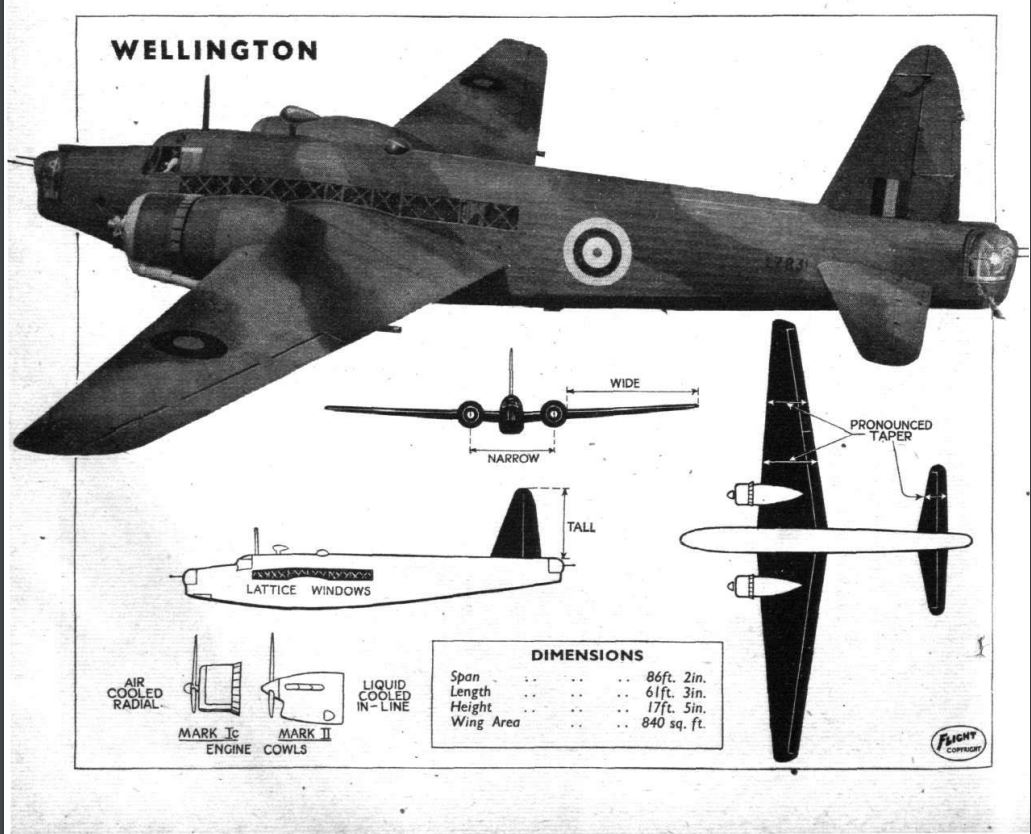
In 1993/94 a local secondary student Kevin Hora carried out a
school project into the crash during which he investigated the
local memory of the event, researched the Irish Armies archives
and most impressively, managed to contact the surviving crew
members.
He, along with the crew, concluded that the aircraft serial number was "T3563", but it is thought this stemmed from the crew log books where aircrew had a habit of recording only the numbers from the aircraft serials, and in this case, the number 3563 and the aircraft squadron letter T must have become transposed together. The serial T3563 was never applied to an aircraft, finding itself in a 'Black out block' instead, blocks of serial numbers not used in an effort to confuse German intelligence as to the actual numbers of aircraft being built.
Telegrams in the service file of Malcolm B Summers indicate
that, as related by the crew in 1993, their aircraft was
equipped with the TR1335, 'GEE' navigational aid.
On the day of the crash, Lt J Ryan of the Irish Air Corps
workshops along with a party of enlisted men, traveled from
Baldonnel to Roscommon for the purposes of establishing what if
any of the aircraft was to be salvaged. His conclusions
were forwarded to the Air Corps on the 5th March as follows:
"I have the honour to report that on
the 1st inst. at 10.00 hours I left for the above job in Air
Corps trailer No. ZD.1758 with a driver, one N.C.O. and six
men. I reported to Comdt. Power, Intelligence Officer, at
Athlone Barracks at 13.00 hours and arranged with him that I
would visit the crash near Ballinlough and remove any
equipment of interest to the Air Corps and that the Command
Engineer would then bring the remaining wreckage to Athlone.
I reached the scene of the crash about 16.00 hours. The
aircraft was a British Wellington Bomber Mark III with
Bristol Hercules engines which had crashed on the night of
the 28/2/43 after her crew of six had left her by
parachute. It had crashed almost vertically on a
ploughed field and was completely destroyed. The only
equipment I removed was six Browning .303 machine guns and
about 1,000 rounds of ammunition. All the guns were
un-serviceable and the major portion of the ammunition was
bent and damaged. The two engines were completely smashed,
not a single cylinder remaining on either of them. I went
carefully through the debris to make sure that no bombs,
flares or other dangerous articles remained. The wreckage is
strewn over four separate fields and it was too late when my
inspection was finished to ascertain the names of the owners
and what claims for damage they proposed to submit. This
matter however will be attended to by the Officer in charge
of the Engineer Company when the clearing up of the wreckage
has been completed. I continued with my party to Boyle
Military Barracks where quarters were provided for the
night."
Lt Ryan in his report records the crash as being in
Garranlahan, the name of two townlands to the west of the
Ballybane townlands.
Kevin Hora in his research had identified a house where a family
named Comer lived, over which the crashing aircraft had skimmed
before impacting the field. This house has been identified
again in a visit to the area in July 2025 and the crash location
matched up to photos sent to the author earlier in the research.
The aircraft had arrived from right to left, the farm buildings
in the center are the former Comer farmhouse. The aircraft
impacted in the fields to the left of the farm buildings.

Kevin Hora's research had discovered the various localities
where the parachuting airmen had landed, in a loose line from
the south east of the crash site. These points are plotted
on the following Google map to illustrate various points
mentioned in the various sources.
The crew of X3563 were released immediately and allowed to
return across the border to Northern Ireland. The Irish
Army report contains no information what so ever about the
dealings with the crew. This information was gleaned some
50 years after the events by Kevin Hora in his contacts with the
veterans.
The same situation had arisen only two weeks prior to to five
of their British squadron mates from 427 Squadron when their Wellington, serial
number, Z1676, was returning from a raid on the German
U-boat pens in the French city of Lorient on the night of
February 17th, 1943. Unable to get a a reliable navigation
signal on their loop equipment, they were forced to crash land
the aircraft due to fuel shortage in a field near
Waterford. Those five airmen, F/Sgt.s Holloway and G C
Slater, W/O Ross, Sgt.s Taylor and Thomas were interned in the
Curragh Camp. Thomas was invalided back to the UK due to
illness, Taylor feigned mental illness and was released, and
Ross injured himself playing rugby and was released. They
were the last Allied personnel interned during the war.
One might expect the same to have happened to the crew of
Wellington X3563 but it would appear that the crew of Z1676 were
interned as a sop to the German legation in Ireland, who had
learned that the American crew
and passengers of a bomber that crashed in Galway had been
released some weeks before.
The veterans testimony was summarized as follows by Kevin Hora as follows:
"Having been informed of the previous
nights incidents, Custume Barracks, Athlone, despatched a
Commandant and driver to pick up the crew. They drove first
to Castlerea, where they picked up Sgts Blue and Somers.
From there, they made their way to Corry's of Kilsallagh,
where they found Sgt Grover, who was, according to Sgt.
Chalk" almost out of sight in a big featherbed, complete
with a thermos of coffee and cigarettes on a bedside table
". The next stop was Williamstown, and while they were there
the Red Cross presented them with two 1,500 page editions of
the works of Lord Clive, to be read during their internment.
Before they left Williamstown, in gratitude for the generous
and welcoming hospitality of the Gardai, they made them a
gift of their torches as token mementos.
Leaving Williamstown in the afternoon, they arrived at
Custume Barracks, Athlone, at four o' clock where they were
met by the Colonel in charge and invited to dinner. When
asked about their flight, they freely admitted that they had
been on a bombing mission. Afterwards, Sgt Southwood was
taken aside and informed by Commandant Power that they would
be escorted to the border that night where the Irish Army
had arranged to hand them over to the RAF. While such a move
in itself was hardly to be expected from a country in
Ireland's position, it was at the border that Commandant
Power was forced to break the rules a little further. After
waiting in a secluded spot for the RAF, who failed to
arrive, he took the decision to cross the border with them.
Taking them to Newtown Butler police station, he handed them
over to the British authorities and, despite a frosty
reception, stayed the night."
Kevin's research was published in two versions, a shorter
version in a local history book and a larger essay version
submitted to a schools competition.
The comings and goings on a Royal Air Force unit were recorded
in the Operations Record book or ORB.
The RAF investigation into the loss of X3563 includes a Form
765 "Report on flying accident or forced landing not
attributable to enemy action".
The crew are listed on this as:
Captain - Southwood, L. G. - Sgt - 656200 - Uninjured
Co. Pilot - Summers, M. B. - Sgt - R128658 - Uninjured
Navigator - Grover, J. C. - Sgt - R96255 - Uninjured
Wireless Operator/Air Gunner - Blue, J. H. - Sgt. R79384 -
Uninjured
Bomb Aimer - Puffer, A. W. - F/Sgt - R105122 - Injured
Air Gunner - Chalk, W. W. N. - Sgt - R100601 - Uninjured
A copy of this was to be found in the service file for M B
Summers.
A report by Sgt Southwood as pilot is included and reads:
"After bombing Target, we set course
for BASE, flying over 10/10th cloud, so were unable to get
pinpoint on the French Coast. The S.B.A. was turned on
but received no beam. Loop bearings gave us a position
Line over East Anglia and we then tried various methods of
attracting attention without success. Eventually we
obtained a "Fix" giving us a position over Ireland but as
the petrol gauges were reaching zero we were unable to reach
England, so we baled out after flying 8 hrs, 20 minutes."
SBA referred to the Standard Beam Approach system carried on
the aircraft, an already outdated prewar blind landing aid.
The conclusion of the Station Commander were rather scathing in
concluding: This incident can
only [be] attributed to
extremely bad navigation. No other aircraft
encountered any trouble in getting back to base.
The crew of Wellington X3563 consisted of five airmen from
Canada and one from Wales. All except Malcolm Summers were
part of an established five man crew which went on to complete a
tour of duty together during 1943. Sgt Summers had
been posted to the Squadron on February 25th, so his first
mission turned into quite an adventure. He had been
assigned to the crew to allow him gain combat experience.
The Canadians, Blue, Puffer, Chalk and Grover it is assumed
started their tour of duty in October 1942 with a posting to 419
Squadron after crew training with 22 Operational Training
Unit. There is little mention of any of the men in the
records of 419 Squadron, except for three possible missions
flown by a "F/Sgt Grover". They are mentioned finally in
November 1942 under a paragraph reading:
"The Squadron ceased to be
operational.”… “Twelve of our crews were attached to
No. 1659 Conversion Unit for training on Halifax
aircraft. The following of our aircrew were posted to
No. 427 Squadron, which was now commencing to form at
?????: Names included are
Sgt Blue, J H
(W/Op.A.G.)…Sgt Chalk W N (A.G.), Sgt. Grover, J C
(Navigator), Sgt Puffer A W (Obs B/A)
It is not known not known if Lyndon Southwood met with
Grover, Puffer, Chalk and Blue at 22 OTU, but this seems likely.
They are first mentioned in the Operations Record Book of 427
Squadron, flying as a five man crew on 7th February 1943.
Some members of the crew had flown missions individually with
other crews in the weeks prior to this. They continued to fly
during February usually with one extra crew member, but always
with Southwood, Grover, Blue, Puffer and Chalk.
The Operations Record Book for 427 Squadron detailed the nights
operations as follows:
[Form 540, 28 Feb. 1943] "Three
aircraft were detailed for daylight bombing operations bit
this was scrubbed. Six aircraft were detailed for a
bombing raid on the Submarine base at ST. NAZAIRE.
Only five took off then being one non-starter due to
mechanical trouble. One aircraft piloted by Sgt
Hartney is missing and one aircraft piloted by Sgt Southwood
ran out of petrol over Southern Ireland and the Crew
parachuted to safety."
The "Sgt Hartney" was actually Sgt W E Harwood, and he and his
crew of five were killed that night over France by a German
nightfighter aircraft.
[Form 541, Feb. 1943] "Target ST.
NAZAIRE. Bomb Load - 1 x 4,000lb. This aircraft
was airborne at 1810 hrs. and crashed in Northern (sic)
Ireland. Crew baled out and all safe. F/S Puffer
suffered leg injuries."
This part of the ORB does state Northern Ireland, but was typed up at the time and could be expected to contain this type of error.
They flew only one more mission with 427 Squadron on April
28th, and shortly after were posted to 429 Squadron. 427
Squadron was due to be re-equipped with Halifax heavy bombers,
but the B Flight Commander took 11 of 427's Wellingtons and 5 of
the crews to create the new 432 Squadron, whilst L G Southwood
and his crew were amongst a number of 427 crew who went to 429
Squadron to continue flying Wellington bombers.
At this time, the roles of navigator and bomb aimer are changed
within the crew. Puffer was now the navigator, and Grover
the bomb aimer
With 429 Squadron they again flew from May 1943 on missions to
targets in Germany along with a small number of sea mine
dropping flights. August 1943 next saw them posted to 432
Squadron, where they flew mainly sea mine dropping
flights, until the night of September 22nd, when Wellington
LN394 crashed on take off from Eastmoor airfield, failing to get
airborne and coming to rest with undercarriage collapsed. No one
was injured it seems and the aircraft itself, LN394, was later
repaired.
They are not mentioned again in the 432 Sqn ORB and it is
assumed that they were posted out of the Squadron as a group or
individually. We do know what became of Sgt Puffer sadly
due to his post war death in 1952, and his postings are
described below.
It was interesting to find in Canadian wartime newspapers that
the men's story of the Irish landing had been published.
These were published in the Sherbrooke Daily Record on May 14
1943 (SGT HARRY BLUE JOINS CATERPILLAR CLUB) and The Ottowa
Citizen on 29 May 1944 (TAKE TO 'CHUTES). The death notice
of M B Summers, shown in his bio, also mentions the landing in
Ireland.
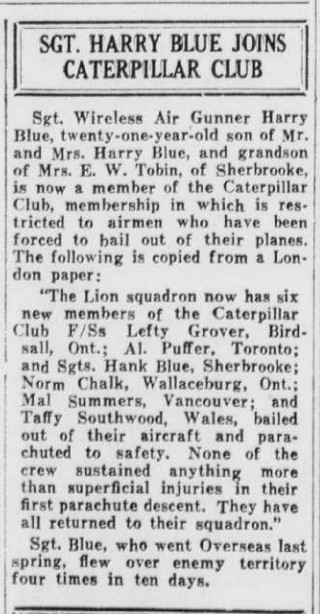
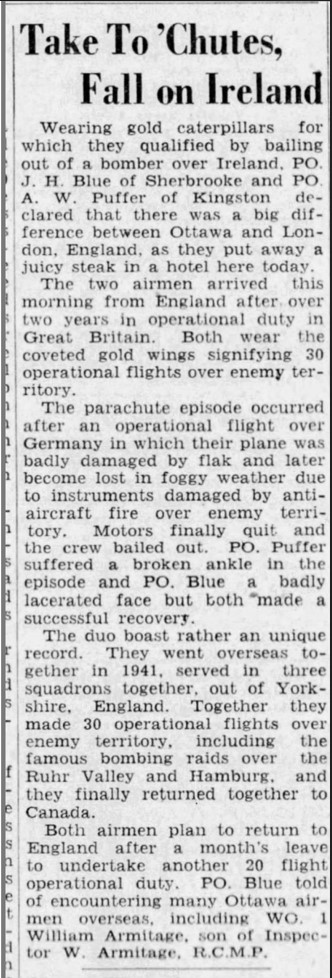
Sgt Lyndon George SOUTHWOOD 656200
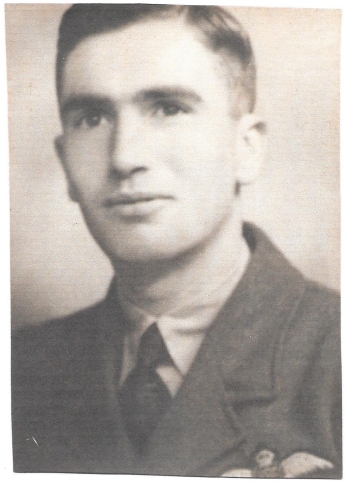 Lyndon
was the only non-Canadian on board the aircraft. He was a
Welshman, the crew captain and first pilot. Lyndon was
born in 1917 in Newport district, the son of Joseph and Anne
Waters. In 1939, he was registered as a sheet mill worker,
living at home with his parents and older brother Hadyn at Hill
Top, Cwmbran. All three men in the household worked in the
steel industry.
Lyndon
was the only non-Canadian on board the aircraft. He was a
Welshman, the crew captain and first pilot. Lyndon was
born in 1917 in Newport district, the son of Joseph and Anne
Waters. In 1939, he was registered as a sheet mill worker,
living at home with his parents and older brother Hadyn at Hill
Top, Cwmbran. All three men in the household worked in the
steel industry.
Lyndon started his wartime military service on 17 January 1940
when he joined the Army. He remained in the Army until 9 May
1941, by which time he had volunteered for, and been accepted
for, service in the RAF.
Lyndon commenced his service with the air force on 10 May 1941 and was sent on a training course in Aberystwyth with 6 Initial Training Wing (ITW).
Lyndon’s Log Books list all his training course and attachments
to Training Units and Training Squadrons both before and after
his Tour of Duty. His training included time in Canada
under the Empire Training Scheme for Bomber Crews from October
1941 to February 1942, where he was awarded his “Wings” or
Flying Badge as a Pilot on 13 February 1942.
On his return to the UK Lyndon continued his training with 6
(P) A.F.U. at Little Rissington, Gloucestershire before going to
22 O.T.U. at Wellesbourne Mountford in August 1942. It was there
that Lyndon met the four Canadians who were to become the other
members of the crew that were to fly a full operational Tour of
Duty together.
Lyndon undertook all but the last mission of his Operational
Tour of Duty as a Non Commissioned Officer, firstly as a
Sergeant and latterly as a Flight Sergeant.
On 22 September 1943, the date of his final mission, Lyndon
received a Commission as an officer in the RAFVR with the rank
of Pilot Officer, “on probation for the emergency” (i.e. the
war). This Commission was “Gazetted” (i.e. appeared in a notice
of promotions in the London Gazette) on 2 November 1943. He did
not do a second Tour of Duty but was trained as, and became, a
Flight Instructor.
Lyndon left active service on 23 November 1945, but remained on
the Reserves list with the Rank of Flight Lieutenant until 1
July 1959, when his Commission was relinquished under the Navy,
Army and Air Force Reserves Act, 1954 and 1959, as set out in a
General Notice in the London Gazette on 23 July 1959.
On 22 September 1943 he received a Commission as a Pilot
Officer. He did not do a second tour of duty but trained as, and
qualified as, a flight instructor, a role he performed for the
rest of the war. He was promoted to Flying Officer on 22 March
1944 and to Flight Lieutenant on 22 September 1945.
He married in 1949 to Nancy, and they lived happily until his death in October 1998 in Bridgend, Wales. He attended reunions in Canada in the 1980's
Sgt Malcolm Barnes SUMMERS R/128658 RCAF
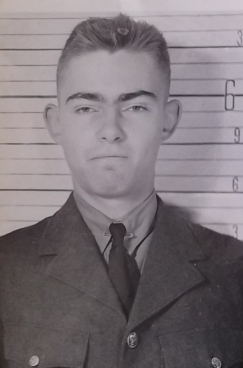 Malcolm was the second
pilot on X3563 on the night of Feb 28th/March 1st 1943 and
Malcolm was the second
pilot on X3563 on the night of Feb 28th/March 1st 1943 and was flying
his very first combat mission.
was flying
his very first combat mission.
The son of Waldo and Ethel Summers, he was born in Malcolm
Summers enlisted in August 1941. He arrived in the UK on
1st September 1942 and was posted to 3 PRC and thence to 12 (P)
AFU on September 12th. From there he went to 22 OTU on
10th October 1942 and was posted to 427 Squadron only on 25 Feb
1943. He flew his first operational mission with the
Southwood crew, on the fateful night they ended up in
Ireland. Following the mishap in Ireland, he was given
command of a crew of his own and was soon posted to 426 squadron
on 6th May 1943 and flew with that unit until he was shot down
on October 7th 1943. He had received his commission as an
officer in July 1943. He and five men from his crew were
killed while two more men from Lancaster DS689 managed to evade
capture and escaped to Spain.
P/O M B Summer J18532 was buried with his crew mates at
Rachecourt-sur-blaise, near Wassy, south of St Dizier, in 1943
and the local populace maintained the unmarked graves until such
time as liberation allowed information to flow back to the UK
and then Canada. By 1945, his mother was writing to the
RCAF asking still if her sons identity had been firmly
established. It would be 1947 before his parents would
learn of his final fate. The remains were exhumed at that
time and identities confirmed. The six men remain the only
Commonwealth
burials in this local French cemetery. The graves
are also marked by a French language plaque which commemorates
their deaths. his death notice in the The Vancouver Daily
Province newspaper on 7 June 1944 carried the article below
mentioning the landing in Ireland.

F/Sgt John Carleton GROVER R/96255 RCAF

F/Sgt Grover was the aircraft's navigator. His commanding
officers heaped blame upon him for the loss in their conclusions
to the investigation carried out after the loss of Wellington
X3563, but not withstanding that, he did continue flying in the
Southwood crew. The veterans were able to explain that his
role as crew navigator was taken up by Alan Puffer, and John
took on the bomb aimer role. This role change is
Born in July 1914 in Ontario to Kathleen and George Grover, he
grew up in Montreal, being found there in the 1921 census of
Canada.
He enlisted in Ottawa in May 1941 and was posted to Toronto for initial processing that summer. His training as an observer, the term used at that time for navigator, took him to 1 AOS at Malton in September 1941, 1 BGS in February 1942 and 2 ANS before being posted overseas in June 1942. He married in 1942, prior to his departure overseas. His name appears in a 1943 syndicated news article along with Chalk about a raid on Hamburg that month stating: Flt. Sgt. J. C. Grover of Birdsall, Ont., jettisoned his bombs because of ice on his wings, then found they fell in the target area anyway.
He was repatriated in November 1944 back to Canada, having been
promoted to officer in November of the previous year. He
was released from duty in the New Year of 1945.
John Grover passed away in 1993. His family donated his
wartime records to the Trent
University Peterborough, Ontario.
Sgt John Henry BLUE R/79384 RCAF
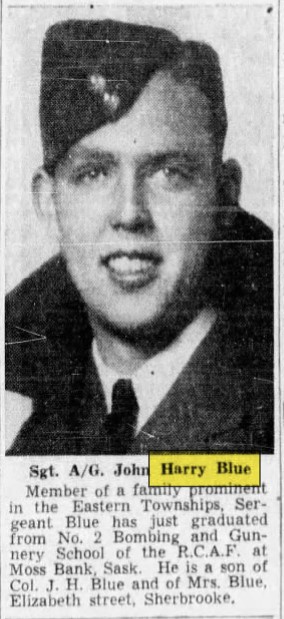 John Blue held the trade of Wireless Operator/Air
Gunner on the crew. He was referred to as known as J Harry
Blue John enlisted in Montreal in April 1941, and
following completion of his basic military training, was posted
to No. 1 Wireless School, that September. This was
followed in February 1942 by a posting to No 8 Bombing and
Gunnery School at Lethbridge, Alberta. He graduated from
there at the end of March 1942 and was posted to England almost
directly afterwards. It is not known what he was posted to
after his time with 432 Squadron but he didn't return to Canada
until August 1945. The Gazette of Montreal published
his commission as an officer and noting that his address was 56
Elizabeth Street, Sherbrooke.
John Blue held the trade of Wireless Operator/Air
Gunner on the crew. He was referred to as known as J Harry
Blue John enlisted in Montreal in April 1941, and
following completion of his basic military training, was posted
to No. 1 Wireless School, that September. This was
followed in February 1942 by a posting to No 8 Bombing and
Gunnery School at Lethbridge, Alberta. He graduated from
there at the end of March 1942 and was posted to England almost
directly afterwards. It is not known what he was posted to
after his time with 432 Squadron but he didn't return to Canada
until August 1945. The Gazette of Montreal published
his commission as an officer and noting that his address was 56
Elizabeth Street, Sherbrooke.
The Canadian Legion listed a F/Lt John Harry BLUE J18846 as
having passed away on 6th May 2004, aged 83. He had been a
member of Col. John Bourque Branch, Sherbrooke, Quebec.
F/Sgt Alan Willett PUFFER R/105122 RCAF
Alan Puffer was originally the Bomb Aimer for this crew, but
later the navigator.
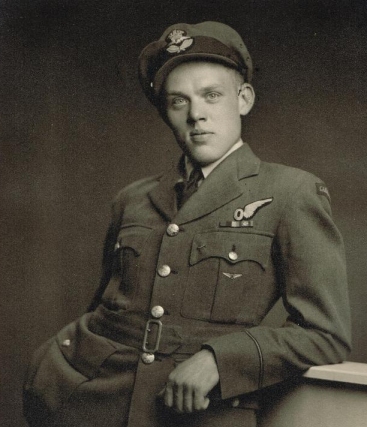
Born in October 1920 in Toronto to Alice Maud and DeWillett S
Puffer.
After his time flying with the Southwood crew, he was posted to
a number of administrative postings during the winter of 1943/44
and between January and May 1944, was posted to 1 (O) AFU, where
it is thought he was tasked as a navigation instructor.
He was granted a period of leave during June and July 1944 back
in Canada. While there the Kingston Whig-Standard
published the following article about Alan's wartime adventures
thus far.
Luftwaffe Still Strong, Flier Says
PO. A. W. Puffer Home on Leave All Commissioned At that time
all the crew were NCO's but last November all re- "German
defences are very good and the Luftwaffe is a long way from
being finished," asserts PO. A.
W. Puffer, 23, RCAF, son of Dr. and Mrs. D. S.
Puffer, who has just returned from two years overseas
after completing his tour of "Ops." Although in a hurry to
get into "civvies" PO. Puffer still wore his blue uniform
when interviewed. On it could be seen, in addition to his
observer's half wing, a horizontal wound stripe on the left
sleeve, an overseas medal, a 1939-43 award, a tour of
operations' award and the little gold caterpillar awarded,
by that famous club to those who bail out. Going overseas in
1942, PO. Puffer, a Toronto boy, soon found excitement.
Stationed with the RCAF Bomber Group of which the now
famous Lion Squadron and the Bison Squadron were part, he
was one of a five-man Wellington bomber crew. On their,
sixth trip over his crew ran into some bad luck. All their
radio equipment went dead over enemy territory and they
headed for where they thought England should be.
Unfortunately their guess was a little wrong and after being
hours in the air on a scheduled seven-hour trip they ran out
of gas and had to bail out over Northern Ireland.
Two Momentos
On that trip he earned his little gold caterpillar and his
wound stripe. The caterpillar for bailing out
and the stripe for hurting his left ankle badly when
landing. He hit hard enough to put his foot in a cast for
eight weeks. None of the others were hurt. As he explained
it "I was the Joe."
In all, he and his buddies made 13
raids on the Ruhr and most of those large ones made on
Hamburg during the period they were flying. Few of these
trips were uneventful. On one occasion they
were attacked by an "Me 110, a twin-engine kite," but
"Jerrie" only succeeded in pouring in a couple of bursts
which did little damage, before being driven off.
One could never disregard "flak" he
declares. On one trip over Lorient gunners were too accurate
and a direct hit started a fire in the right motor, putting
it out of commission. After the fire was extinguished they
winged their way home on the other motor. Safely, too.
On one trip, made in bad weather, they had a narrow
escape with one of their own bombers. It a dark night and
they were headed for home when just outside of Hamburg,
"Taffy" Southwood, their Welsh pilot, saw a Halifax bomber
coming right at them. Just in time he dove and the Halifax
went gliding overhead with a dull rumble of roaring motors.
Others in crew PO. Puffer flew with all the time over there
were: "Lefty" Grover of Toronto, bomb aimer; Harry Blue of
Sherbrooke, wireless operator, and Norm Chalk of Toronto,
tail gunner.
At that time all the crew were NCO's but last November
all received commissions. PO. Puffer and his had tough luck
on their last operation. Just they taking off for their last
flight their right motor "conked out," they went over a
ditch and a highway tearing their undercarriage off, and
crashed in a field demolishing their "kite." Not one was
hurt.
When interviewed PO. Puffer
inquired about the whereabouts of William Hackett, father of
FO. Doug Hackett, DFC, who was reported missing over enemy
territory some time ago. He and Doug, whose father lives at
69 Ordnance Street, had chummed around while over there.
When last seen PO. Puffer was trying
to get acquainted with Kingston, a strange city to
him. At present he is on 30 day' leave.
After his leave he was posted back to the UK and was later
posted to 419 Squadron flying on Lancaster bombers, and here he
flew another tour of duty with Bomber Command through until VE
day.
He sailed back to back to New York in May 5 1945 on the SS
Lejeune, identifiable by his officers serial number J19142 and
trade of Nav.B., Navigator Bombardier.
Alan married in 1948 to Joy Green, and they had a son.
Tragically, Alan was killed in October 1952 in car accident and
is buried with his parents in Park Lawn Cemetery in
Toronto. Joy gave birth to a daughter in May of the
following year.
The photo shown comes from the 1950 University of Toronto
Yearbook, Torontonensis.
Sgt William Norman CHALK R/100601 RCAF

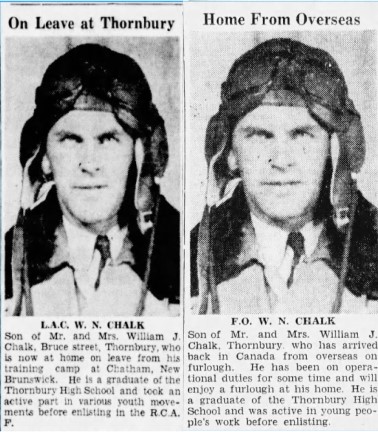 Bill Chalk
was an Air Gunner on the Wellington. He was born in 1912
to Mary and William Chalk in Thornbury, Ontario. His local
newspaper the Sun Times reported occasionaly on his wartime
movements, mainly while he was stationed in Canada. in
William Chalk died in on 28 February 2001 in London,
Ontario. In February 1941, they printed that he had signed
up with the RCAF and would be reporting to Toronto. At the
end of that month, he was presented with a fountain pen and
pencil by his local tennis club in honor of his volunteering for
service. He later in March was presented with a special
bound testament by Baptist Young People of Thornbury. He
was back visiting his parents in June of that year. A
further period of leave in November preceded him being posted to
Trenton and he was back again in December. he was due to
go for a further three months training after another leave in
April 1942.
Bill Chalk
was an Air Gunner on the Wellington. He was born in 1912
to Mary and William Chalk in Thornbury, Ontario. His local
newspaper the Sun Times reported occasionaly on his wartime
movements, mainly while he was stationed in Canada. in
William Chalk died in on 28 February 2001 in London,
Ontario. In February 1941, they printed that he had signed
up with the RCAF and would be reporting to Toronto. At the
end of that month, he was presented with a fountain pen and
pencil by his local tennis club in honor of his volunteering for
service. He later in March was presented with a special
bound testament by Baptist Young People of Thornbury. He
was back visiting his parents in June of that year. A
further period of leave in November preceded him being posted to
Trenton and he was back again in December. he was due to
go for a further three months training after another leave in
April 1942.
Little mention is found of him during 1943 and 1944 until
mention in October 1944 when he is back with his parents and due
to go on a posting to Lachine, Quebec.
His name appears in a 1943 syndicated news article about a raid
on Hamburg that month and the experience of the crews. His
mention states: The storm caused
Flt. Sgt. W. N. Chalk of Thornbury, ont. to barely miss a
collision with a Halifax bomber.
His photo is found published at the bookends to his wartime
career, in December 1941 and September 1944. On that date
they published the following, which possibly alluded to his
short visit to Ireland. On
Furlough from Overseas Flying Officer W. N. Chalk,
R.C.A.F., son of Mr and Mrs Chalk of Thornbury, is among
those who have arrived in Canada from overseas, and is
expected to arrive at his home on Friday evening. It
expected he will remain for an extended visit. F.O.
Chalk has been overseas for the past two and a half years
and has completed a full tour of operations. On one occasion
following a raid over Hamburg he was reported missing for a
period of five days, but turned up safely and was
uninjured. For several months past he has been
instructing in Britain. He is 31 years of age and
prior to enlisting in the R.C.A.F. was active in the youth
movement in and around Thornbury.
Theses photos of the crew members are in the Hora report from
1994, and it is hoped that the families can find the original
photos again to rescan them in a clearer format.
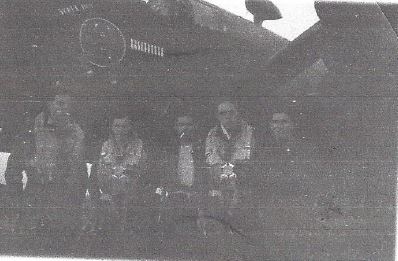
The crew in this five man photo are, left to right: Blue,
Grover, Chalk, Puffer and Southwood.
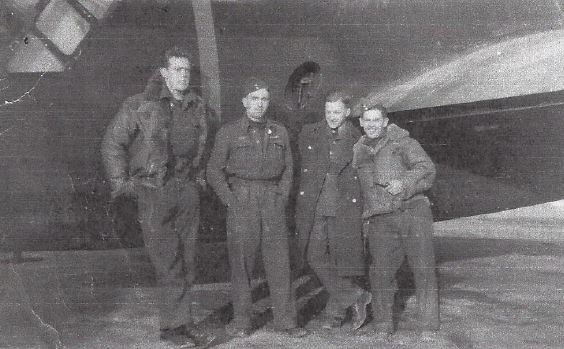
In this image above, the four airmen are from the left, Blue,
Southwood, Grover and Chalk next to a Wellington bomber.
The window displays the Wellingtons geodetic method of
construction.
In later years the four survivors after 1952 stayed in contact
and met at reunions. Some photos from these are shown
below.
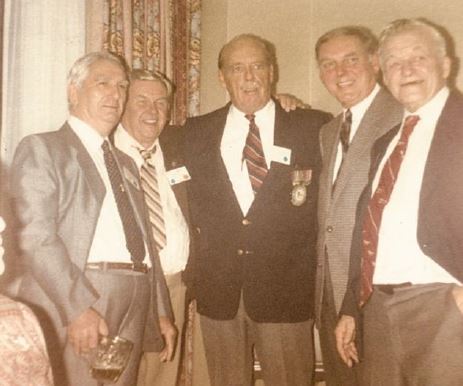
Left to right: Lyndon Southwood, Norman Chalk, John Blue,
Douglas Puffer, brother of Alan Puffer and John Grover

Left to right: John Grover, Norman Chalk and Lyndon Southwood
This wonderful group shot was left by John Grover and shows him
with a group of trainees over the winter of 1941/42. The
surnames recorded allowed the names to be confirmed by a
historian of the British Common wealth Air Training Plan.
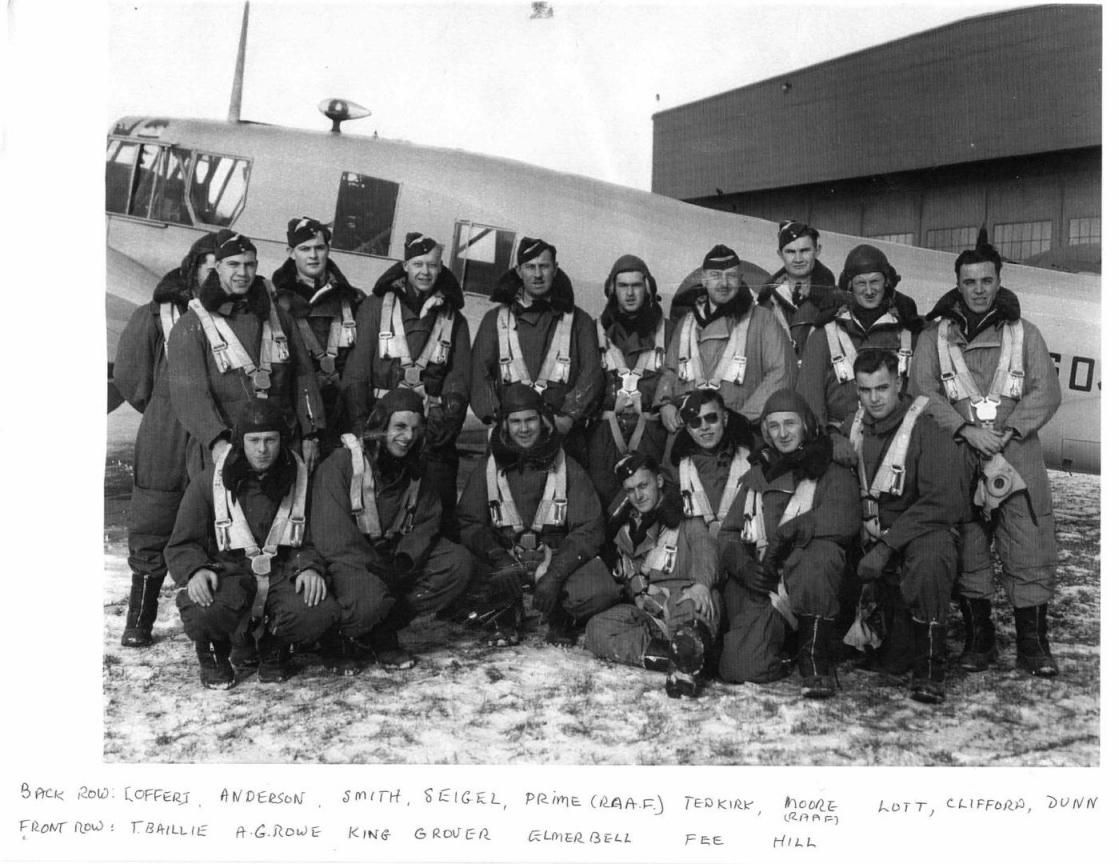
1) Sgt. Robert Fred Lindsay ANDERSON (R/103209) (Waterloo, ON);
2) Sgt. Shannon Stanley Joseph Hobb SMITH (R/904458);
3) Sgt. Everett Kingsley SEIGEL (Toronto, ON);
4) Sgt. Leslie Arthur Jacob PRIME (AUS402902) (
Cremorne, NSW, Australia);
5) Sgt. John William MOORE (AUS403943);
6) Sgt. William Lesley LOTT (R/99690) (London, ON);
7) Sgt. John Sanfield CLIFFORD (R/95600);
8) Sgt. G.W. DUNN (Toronto, ON);
9) Sgt. Thomas BAILLIE (R/99629) (Stratford, ON);
10) Sgt. Alfred George ROWE (R/102799) (Toronto, ON);
11) Sgt. Donald Chesley KING (R/104886) (Verdun, PQ);
12) Sgt. Elmer Warrenner BELL (Hanover, ON);
13) Sgt. Robert Andrews FEE (R/90718) (North Bay, ON); and
14) Sgt. Vernon Peter Bruce HILL (R/103165) (St. Catharines,
ON).,
Converted to digital format by Dennis Burke with addition of information in 2023, Dublin and Sligo. It wouldn't be possible without the great assistance of the families and friends of the Southwood, Grover, Puffer, Chalk and Blue families. A big thank you to Kevin Hora. If you have information on any of the people listed above, please do contact me at dp_burke@yahoo.com
